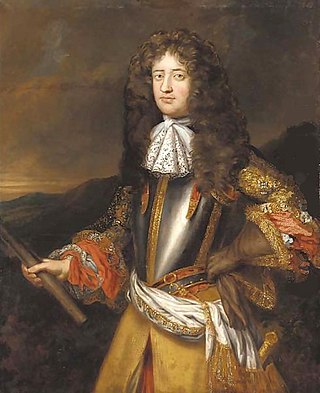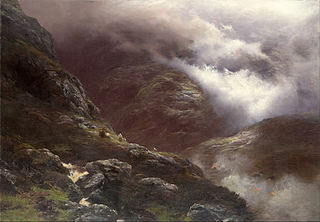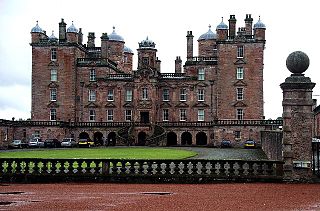Related Research Articles

The Battle of Killiecrankie, also referred to as the Battle of Rinrory, took place on 27 July 1689 during the 1689 Scottish Jacobite rising. An outnumbered Jacobite force under Sir Ewen Cameron of Lochiel and John Graham, Viscount Dundee, defeated a government army commanded by General Hugh Mackay.

Field Marshal George Hamilton, 1st Earl of Orkney,, styled Lord George Hamilton from 1666 to 1696, was a British soldier and Scottish nobleman and the first British Army officer to be promoted to the rank of field marshal. After commanding a regiment for the cause of William of Orange during the Williamite War in Ireland, he commanded a regiment in the Low Countries during the Nine Years' War. He then led the final assault at the Battle of Blenheim attacking the village churchyard with eight battalions of men and then receiving the surrender of its French defenders during the War of the Spanish Succession. He also led the charge of fifteen infantry battalions in an extremely bloody assault on the French entrenchments at the Battle of Malplaquet. In later life, he became a Lord of the Bedchamber to George I and was installed as Governor of Edinburgh Castle.

Hugh Mackay was a Scottish military officer who settled in the Netherlands, and spent most of his career in the service of William of Orange.

Major-General George Douglas, 1st Earl of Dumbarton KT was a Scottish military officer who spent much of his career in the service of King Louis XIV. In 1678, he returned to England; as a Catholic, he was a trusted servant of King James II and went into exile with him after the 1688 Glorious Revolution. He died at the palace of St Germain-en-Laye in March, 1692.
John Maitland, 5th Earl of Lauderdale was a Scottish judge and politician who supported the Acts of Union.
Brigadier-General John Middleton MP was a British Army officer and Scottish Whig politician who sat in the House of Commons almost continuously between 1713 and 1739.

The 7th Queen's Own Hussars was a cavalry regiment in the British Army, first formed in 1689. It saw service for three centuries, including the First World War and the Second World War. The regiment survived the immediate post-war reduction in forces, but following the 1957 Defence White Paper, it was amalgamated with the 3rd The King's Own Hussars, forming the Queen's Own Hussars in 1958.
Alexander Cannon was a Scottish professional soldier in the second half of the 17th century, who served in the armies of William of Orange and James VII and II.
Lieutenant-General William Kerr, 2nd Marquess of Lothian, was a Scottish peer who held a number of minor military and political offices. He was known by the courtesy title of Lord Newbattle until 1692, when he succeeded as Lord Jedburgh, then as Marquess of Lothian when his father died in 1703.

Brigadier-General Henry Trelawny was a British Army officer of Cornish descent, a Member of Parliament and Vice-Admiral of Cornwall.
George Livingston PC was a military officer and third Earl of Linlithgow.

Robert Duncanson, 1658 to May 1705, was a Scottish professional soldier from Inveraray; a retainer of the Earl of Argyll, he began his career during the 1685 Argyll's Rising, and is now best remembered for his involvement in the February 1692 Glencoe massacre.

Charles Cathcart, 8th Lord Cathcart was a British Army officer and peer.
Hugh Sempill, 12th Lord Sempill was a Scottish soldier.
Thomas Buchan (c.1641–1724) was a Scottish professional soldier from a Catholic family in Aberdeenshire who served in the armies of France, the Netherlands and Scotland. He remained loyal to James II after the 1688 Glorious Revolution and participated in the War in Ireland before taking command of Jacobite forces in Scotland in February 1690. After the Highland chiefs submitted to William III in early 1692, he was given safe passage to France and later allowed to return home in 1703. He maintained links with the Stuart exiles and played a small role in the 1715 Rising but escaped punishment and died at Fyvie in 1724.

Lieutenant-General George Ramsay was a younger son of the Earl of Dalhousie and Scottish professional soldier.

Lieutenant-General James Douglas (1645–1691), younger brother of the Duke of Queensberry, was a Scottish military officer, who served as MP for Peeblesshire in the 1685 to 1686 Parliament of Scotland.

General William Charles Forrest was a senior officer in the British Army.

Sir Thomas Livingstone, Viscount Teviot was a military officer of Scottish descent who was born in the Dutch Republic, and spent his career in the service of William of Orange.
Brigadier-general William Wolseley, PC was an English army officer who fought in the Williamite War in Ireland.
References
- 1 2 3 "scotsmag.com - Battle of Killiecrankie 1689". www.scotsmag.com. Retrieved 2018-04-29.
- ↑ Zhulin, Denis Larionov & Alexander. "Read the eBook Publications of the Scottish History Society (Volume 32) by Scottish History Society. cn online for free (page 50 of 59)". www.ebooksread.com. Retrieved 2018-04-29.
- ↑ Barrett, Charles Raymond Booth (2008) [1914]. "Appendix 1: Officers: 1690-1714". The 7th(Queen's Own) Hussars: Uniforms, Equipment, Weapons, Traditions, the Services of Notable Officers and Men & the Appendices to All Volumes. Volume 4: 1688-1914. Vol. 4. Leonaur Books. pp. 152, 153. ISBN 978-1-84677-521-5.
- ↑ Childs, John (1987). The British Army of William III, 1689-1702. Manchester University Press. ISBN 978-0719019876.
- ↑ Paul, James Balfour. The Scots peerage; founded on Wood's edition of Sir Robert Douglas's peerage of Scotland; containing an historical and genealogical account of the nobility of that kingdom. Edinburgh: D. Douglas.